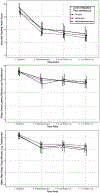Do treatment effects of a web-based cognitive behavioral therapy for insomnia intervention differ for users with and without pain interference? A secondary data analysis
- PMID: 31152334
- PMCID: PMC6885103
- DOI: 10.1007/s10865-019-00065-w
Do treatment effects of a web-based cognitive behavioral therapy for insomnia intervention differ for users with and without pain interference? A secondary data analysis
Abstract
Cognitive-behavioral therapy for insomnia (CBT-I) shows treatment benefits among individuals with pain interference; however, effects of Internet-delivered CBT-I for this population are unknown. This secondary analysis used randomized clinical trial data from adults assigned to Internet-delivered CBT-I to compare changes in sleep by pre-intervention pain interference. Participants (N = 151) completed the Insomnia Severity Index (ISI) and sleep diaries [sleep onset latency (SOL); wake after sleep onset (WASO)] at baseline, post-assessment, 6- and 12-month follow-ups. Linear mixed-effects models showed no differences between pain interference groups (no, some, moderate/severe) for changes from baseline to any follow-up timepoint for ISI (p = .72) or WASO (p = .88). There was a small difference in SOL between those reporting some versus no or moderate/severe pain interference (p = .04). Predominantly comparable and sustained treatment benefits for both those with and without pain interference suggest that Internet-delivered CBT-I is promising for delivering accessible care to individuals with comorbid pain and insomnia.
Keywords: Cognitive behavioral therapy; Comorbidity; Insomnia; Internet; Pain interference.
Conflict of interest statement
Conflicts: Shaffer, Camacho, Lord, Chow, Palermo, Law, and Ingersoll have no conflicts of interest to disclose. Thorndike and Ritterband report having equity ownership in BeHealth Solutions, LLC, a company that develops and makes available products related to the research reported in this article. Specifically, BeHealth Solutions, LLC, has licensed the Sleep Healthy Using the Internet (SHUTi) program and the software platform on which it was built from the University of Virginia. The terms of this arrangement have been reviewed and approved by the University of Virginia in accord with its conflict of interest policy.
Figures
Similar articles
-
Cognitive behavioral treatments for insomnia and pain in adults with comorbid chronic insomnia and fibromyalgia: clinical outcomes from the SPIN randomized controlled trial.Sleep. 2019 Mar 1;42(3):zsy234. doi: 10.1093/sleep/zsy234. Sleep. 2019. PMID: 30496533 Free PMC article. Clinical Trial.
-
Long-Term Effects of an Unguided Online Cognitive Behavioral Therapy for Chronic Insomnia.J Clin Sleep Med. 2019 Jan 15;15(1):101-110. doi: 10.5664/jcsm.7580. J Clin Sleep Med. 2019. PMID: 30621837 Free PMC article. Clinical Trial.
-
Effect of a Web-Based Cognitive Behavior Therapy for Insomnia Intervention With 1-Year Follow-up: A Randomized Clinical Trial.JAMA Psychiatry. 2017 Jan 1;74(1):68-75. doi: 10.1001/jamapsychiatry.2016.3249. JAMA Psychiatry. 2017. PMID: 27902836 Clinical Trial.
-
Internet-Delivered Cognitive Behavioral Therapy for Insomnia: Tailoring Cognitive Behavioral Therapy for Insomnia for Patients with Chronic Insomnia.Sleep Med Clin. 2020 Jun;15(2):117-131. doi: 10.1016/j.jsmc.2020.02.001. Sleep Med Clin. 2020. PMID: 32386688 Review.
-
Internet-Delivered Cognitive Behavioral Therapy for Insomnia: Tailoring Cognitive Behavioral Therapy for Insomnia for Patients with Chronic Insomnia.Sleep Med Clin. 2019 Sep;14(3):301-315. doi: 10.1016/j.jsmc.2019.04.002. Epub 2019 Jun 5. Sleep Med Clin. 2019. PMID: 31375200 Review.
Cited by
-
Prevention of Pain Interference in Insomnia Patients via Digital Cognitive-Behavioral Therapy for Insomnia.Behav Sleep Med. 2025 Sep-Oct;23(5):593-605. doi: 10.1080/15402002.2025.2500519. Epub 2025 May 5. Behav Sleep Med. 2025. PMID: 40324067 Clinical Trial.
-
Effectiveness of digital Cognitive-Behavioural Therapy for Insomnia in patients with musculoskeletal complaints and insomnia in primary care physiotherapy: study protocol for a randomised controlled trial.BMJ Open. 2024 Aug 21;14(8):e083592. doi: 10.1136/bmjopen-2023-083592. BMJ Open. 2024. PMID: 39174064 Free PMC article.
-
The complexities of the sleep-pain relationship in adolescents: A critical review.Sleep Med Rev. 2023 Feb;67:101715. doi: 10.1016/j.smrv.2022.101715. Epub 2022 Nov 12. Sleep Med Rev. 2023. PMID: 36463709 Free PMC article. Review.
-
App-Delivered Cognitive-Behavioral Therapy for Insomnia Among Patients with Comorbid Musculoskeletal Complaints and Insomnia Referred to 4-Week Inpatient Multimodal Rehabilitation: Protocol for a Randomized Clinical Trial.Nat Sci Sleep. 2023 Oct 11;15:799-809. doi: 10.2147/NSS.S419520. eCollection 2023. Nat Sci Sleep. 2023. PMID: 37850197 Free PMC article.
-
Effects of schedule exercise therapy on chronic insomnia.Medicine (Baltimore). 2022 Sep 23;101(38):e30792. doi: 10.1097/MD.0000000000030792. Medicine (Baltimore). 2022. PMID: 36197264 Free PMC article.
References
-
- Association A. P. (2013). Diagnostic and statistical manual of mental disorders, 5th Edition (DSM-5).
-
- Austrian JS, Kerns RD, & Reid MC (2005). Perceived Barriers to Trying Self-Management Approaches for Chronic Pain in Older Persons. Journal of the American Geriatrics Society, 53(5), 856–861. - PubMed
-
- Bastien CH, Vallières A, & Morin CM (2001). Validation of the Insomnia Severity Index as an outcome measure for insomnia research. Sleep Medicine, 2(4), 297–307. - PubMed
-
- Currie SR, Wilson KG, Pontefract AJ, & deLaplante L (2000). Cognitive behavioral treatment of insomnia secondary to chronic pain. Journal of Consulting and Clinical Psychology, 68(3), 407–416. - PubMed
Publication types
MeSH terms
Grants and funding
LinkOut - more resources
Full Text Sources
Medical


